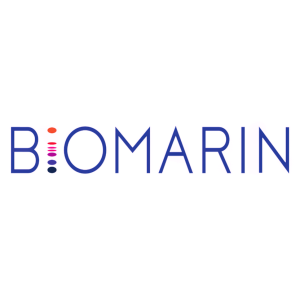BioMarin to Present ROCTAVIAN™ (valoctocogene roxaparvovec-rvox) Data Highlighting Long-Term Durability at 2024 European Association for Haemophilia and Allied Disorders (EAHAD) Congress
New Seven-Year Follow-Up Phase 2 Study Results Showed Durable Hemostatic Benefit for Adults with Severe Hemophilia A
Results from a Phase 2, open-label study of ROCTAVIAN showed that median factor VIII (FVIII) activity at year seven remained in the mild hemophilia range (10.3 IU/dL per chromogenic assay), and mean annualized bleeding rate (ABR) for treated bleeds over the full follow-up period decreased by
"People living with severe hemophilia A face a lifelong treatment burden, including frequent injections or infusions and a high risk of health complications like uncontrolled bleeding and irreversible joint damage, which may persist despite good adherence to prophylactic therapy," said Hank Fuchs, M.D., President of Worldwide Research and Development at BioMarin. "We are pleased to present data showing the impact of one-time treatment with ROCTAVIAN over seven years following the infusion, underscoring the potential of gene therapy to make a meaningful and long-lasting impact for people living with severe hemophilia A."
Additional studies will be shared during oral presentations on Friday, Feb. 9 from 8:30-10:00 a.m. CET, including preliminary results from GENEr8-INH, a Phase 1/2 study evaluating the safety and efficacy of ROCTAVIAN in participants with active and prior FVIII inhibitors, as well as one-year results from GENEr8-3, a Phase 3b study evaluating the use of prophylactic corticosteroids with ROCTAVIAN treatment.
BioMarin's key presentations at EAHAD include:
Poster Presentations:
Seven-year follow-up of valoctocogene roxaparvovec gene therapy for haemophilia A
#PO124
Wednesday, Feb. 7, 2024, 6:30-7:30 p.m. CET
Treatment preferences in people with severe haemophilia A: a discrete choice experiment in
#PO314
Wednesday, Feb. 7, 2024, 6:30-7:30 p.m. CET
Health-related quality of life and long-term joint damage in people with severe haemophilia A in
#PO144
Wednesday, Feb. 7, 2024, 6:30-7:30 p.m. CET
Oral Presentations:
Safety and efficacy of valoctocogene roxaparvovec in participants with active and prior FVIII inhibitors: preliminary results from GENEr8-INH, a phase 1/2 study
#OR10
Friday, Feb. 9, 2024, 8:30-10:00 a.m. CET
Safety and efficacy of valoctocogene roxaparvovec with prophylactic corticosteroids: 1-year GENEr8-3 results
#OR02
Friday, Feb. 9, 2024, 8:30-10:00 a.m. CET
Human liver biopsy analysis reveals lower RNA transcription may contribute to a decline in FVIII levels following AAV5-hFVIII-SQ gene therapy
#OR06
Friday, Feb. 9, 2024, 8:30-10:00 a.m. CET
About Hemophilia A
Hemophilia A, also called factor VIII (FVIII) deficiency or classic hemophilia, is an X-linked genetic disorder caused by missing or defective FVIII, a clotting protein. Although it is passed down from parents to children, about one-third of cases are caused by a spontaneous mutation, a new mutation that was not inherited. Approximately 1 in 10,000 people have hemophilia A.
About ROCTAVIAN
ROCTAVIAN is an adeno-associated virus vector-based gene therapy used for the treatment of adults with severe hemophilia A who do not have antibodies to adeno-associated virus serotype 5 (AAV5), which is determined by a blood test. The one-time infusion works by delivering a functional gene that is designed to enable the body to produce FVIII on its own, reducing the need for ongoing prophylaxis.
The European Commission (EC) granted conditional marketing authorization to ROCTAVIAN on August 24, 2022. The
More information on testing to determine eligibility to receive ROCTAVIAN can be found at https://www.ROCTAVIAN.com in the
ROCTAVIAN
Contraindications: Patients with active infections, either acute (such as acute respiratory infections or acute hepatitis) or uncontrolled chronic (such as chronic active hepatitis B). Patients with known significant hepatic fibrosis (stage 3 or 4 on the Batts-Ludwig scale or equivalent), or cirrhosis, and patients with known hypersensitivity to mannitol.
Infusion-related reactions including hypersensitivity reactions and anaphylaxis, have occurred. Monitor during and for at least 3 hours after ROCTAVIAN administration. Administer ROCTAVIAN in a setting where personnel and equipment are immediately available to treat infusion-related reactions. Discontinue infusion for anaphylaxis.
Hepatotoxicity: The safety and effectiveness of ROCTAVIAN in patients with hepatic impairment has not been established. Perform liver health assessments prior to administration. The majority of patients treated with ROCTAVIAN experienced ALT elevations and required corticosteroids for ALT elevation. Assess patient's ability to receive corticosteroids and/or other immunosuppressive therapy that may be required for an extended period. Live vaccines should not be administered to patients while on immunosuppressive therapy.
Monitor ALT weekly for at least 26 weeks and as clinically indicated, during corticosteroid therapy and institute corticosteroid treatment in response to ALT elevations as required. Continue to monitor ALT until it returns to baseline. Monitor factor VIII activity levels since ALT elevation may be accompanied by a decrease in factor VIII activity. One case of autoimmune hepatitis was reported during third year follow-up in a patient with history of hepatitis C and steatohepatitis.
It is recommended that patients abstain from consuming alcohol for at least 1 year after administration and thereafter limit alcohol use. Concomitant medications may cause hepatotoxicity, decrease factor VIII activity, or change plasma corticosteroid levels which may impact liver enzyme elevation and/or factor VIII activity or decrease the efficacy of the corticosteroid regimen or increase their side effects. Closely monitor concomitant medication use including herbal products and nutritional supplements and consider alternative medications in case of potential drug interactions.
Thromboembolic events: Factor VIII activity above ULN has been reported following ROCTAVIAN infusion. Thromboembolic events may occur in the setting of elevated factor VIII activity above ULN. Evaluate patients for risk of thrombosis including general cardiovascular risk factors before and after administration of ROCTAVIAN. Advise patients on their individual risk of thrombosis in relation to their factor VIII activity levels above ULN and consider prophylactic anticoagulation. Advise patients to seek immediate medical attention for signs or symptoms indicative of a thrombotic event.
Factor VIII inhibitors and Monitoring for inhibitors: The safety and effectiveness of ROCTAVIAN in patients with prior or active factor VIII inhibitors have not been established. Patients with active factor VIII inhibitors should not take ROCTAVIAN. Following administration, monitor patients for factor VIII inhibitors (neutralizing antibodies to factor VIII). Test for factor VIII inhibitors especially if bleeding is not controlled, or plasma factor VIII activity levels decrease.
Monitor Factor VIII using the same schedule for ALT monitoring. It may take several weeks after ROCTAVIAN infusion before ROCTAVIAN-derived factor VIII activity rises to a level sufficient for prevention of spontaneous bleeding episodes. Exogenous factor VIII or other hemostatic products may also be required in case of surgery, invasive procedures, trauma, or bleeds. Consider more frequent monitoring in patients with factor VIII activity levels ≤ 5 IU/dL and evidence of bleeding, taking into account the stability of factor VIII levels since the previous measurement.
Factor VIII activity produced by ROCTAVIAN in human plasma is higher if measured with one-stage clotting assays compared to chromogenic substrate assays. When switching from hemostatic products prior to ROCTAVIAN treatment, physicians should refer to the relevant prescribing information to avoid the potential for factor VIII activity assay interference during the transition period.
Malignancy: The integration of liver-targeting AAV vector DNA into the genome may carry the theoretical risk of hepatocellular carcinoma development. ROCTAVIAN can also insert into the DNA of other human body cells. Monitor patients with risk factors for hepatocellular carcinoma (e.g., hepatitis B or C, non-alcoholic fatty liver disease, chronic alcohol consumption, non-alcoholic steatohepatitis, advanced age) with regular liver ultrasound (e.g., annually) and alpha-fetoprotein testing for 5 years following ROCTAVIAN administration. In the event that any malignancy occurs after treatment with ROCTAVIAN, contact BioMarin Pharmaceutical Inc. at 1-866-906-6100.
Most Common Adverse Reactions: Most common adverse reactions (incidence ≥
Isotretinoin, Efavirenz, and HIV Positive Patients: Isotretinoin is not recommended in patients who are benefiting from ROCTAVIAN. Efavirenz is not recommended in patients treated with ROCTAVIAN. Clinical studies of ROCTAVIAN did not include sufficient numbers of patients with HIV to determine whether the efficacy and safety differs compared to patients without HIV infection.
Females and Males of Reproductive Potential: ROCTAVIAN is not intended for administration in women. There are no data on the use of ROCTAVIAN in pregnant women or regarding lactation. For 6 months after administration of ROCTAVIAN, men of reproductive potential and their female partners must prevent or postpone pregnancy using an effective form of contraception, and men must not donate semen.
You may report side effects to the FDA at (800) FDA-1088 or www.fda.gov/medwatch. You may also report side effects to BioMarin at 1-866-906-6100.
Please see the ROCTAVIAN full Prescribing Information for additional Important Safety Information.
About BioMarin
Founded in 1997, BioMarin is a global biotechnology company dedicated to transforming lives through genetic discovery. The company develops and commercializes targeted therapies that address the root cause of genetic conditions. BioMarin's unparalleled research and development capabilities have resulted in eight transformational commercial therapies for patients with rare genetic disorders. The company's distinctive approach to drug discovery has produced a diverse pipeline of commercial, clinical, and pre-clinical candidates that address a significant unmet medical need, have well-understood biology, and provide an opportunity to be first-to-market or offer a substantial benefit over existing treatment options. For additional information, please visit www.biomarin.com.
Forward-Looking Statements
This press release contains forward-looking statements about the business prospects of BioMarin Pharmaceutical Inc. (BioMarin), including, without limitation, statements about: the data BioMarin plans to present at the 2024 European Association for Haemophilia and Allied Disorders (EAHAD) Congress, including the three oral and three poster presentations; the development of BioMarin's ROCTAVIAN program; the potential impact and benefits of ROCTAVIAN for people with severe hemophilia A; and the continued clinical development of ROCTAVIAN. These forward-looking statements are predictions and involve risks and uncertainties such that actual results may differ materially from these statements. These risks and uncertainties include, among others: BioMarin's success in the commercialization of ROCTAVIAN, including achieving adequate market share and reimbursement levels; whether ROCTAVIAN will have the impacts and benefits as anticipated; the results and timing of current and planned preclinical studies and clinical trials of ROCTAVIAN and the release of data from those trials, including continued monitoring of the participants in the clinical trials and post-approval studies; BioMarin's ability to successfully manufacture ROCTAVIAN for the clinical trials and commercially; the content and timing of decisions by the FDA, EU health authorities and other regulatory authorities regarding ROCTAVIAN; and those factors detailed in BioMarin's filings with the Securities and Exchange Commission, including, without limitation, the factors contained under the caption "Risk Factors" in BioMarin's Quarterly Report on Form 10-Q for the quarter ended September 30, 2023, as such factors may be updated by any subsequent reports. Stockholders are urged not to place undue reliance on forward-looking statements, which speak only as of the date hereof. BioMarin is under no obligation, and expressly disclaims any obligation to update or alter any forward-looking statement, whether as a result of new information, future events or otherwise.
BioMarin® is a registered trademark of BioMarin Pharmaceutical Inc. ROCTAVIAN™ is a trademark of BioMarin Pharmaceutical Inc. in
Contacts: | |
Investors | Media |
Traci McCarty | Andrew Villani |
BioMarin Pharmaceutical Inc. | BioMarin Pharmaceutical Inc. |
(415) 455-7558 | (628) 269-7393 |
![]() View original content to download multimedia:https://www.prnewswire.com/news-releases/biomarin-to-present-roctavian-valoctocogene-roxaparvovec-rvox-data-highlighting-long-term-durability-at-2024-european-association-for-haemophilia-and-allied-disorders-eahad-congress-302053882.html
View original content to download multimedia:https://www.prnewswire.com/news-releases/biomarin-to-present-roctavian-valoctocogene-roxaparvovec-rvox-data-highlighting-long-term-durability-at-2024-european-association-for-haemophilia-and-allied-disorders-eahad-congress-302053882.html
SOURCE BioMarin Pharmaceutical Inc.








